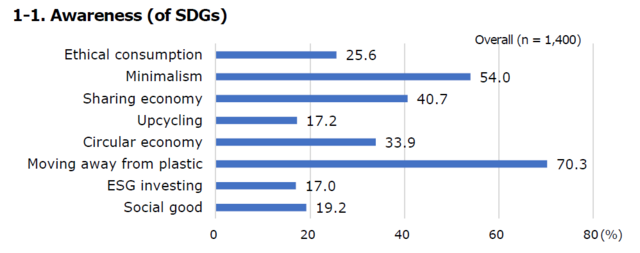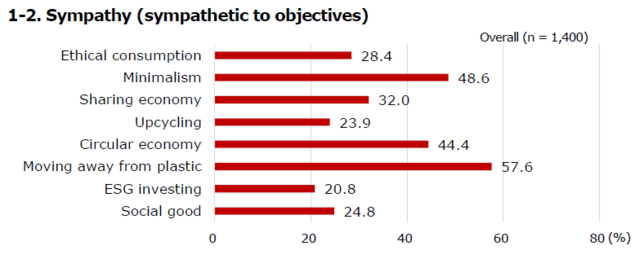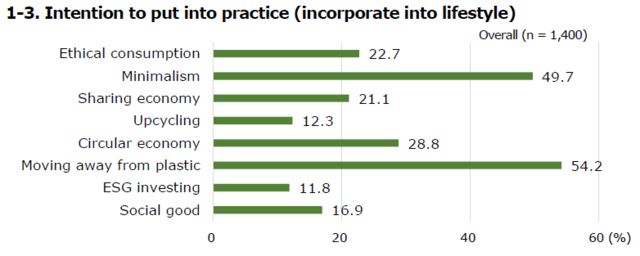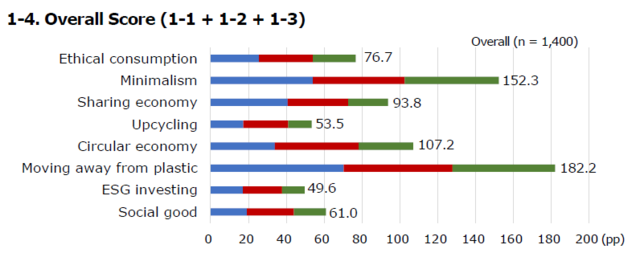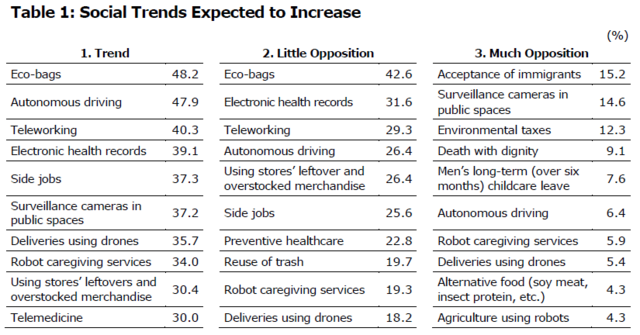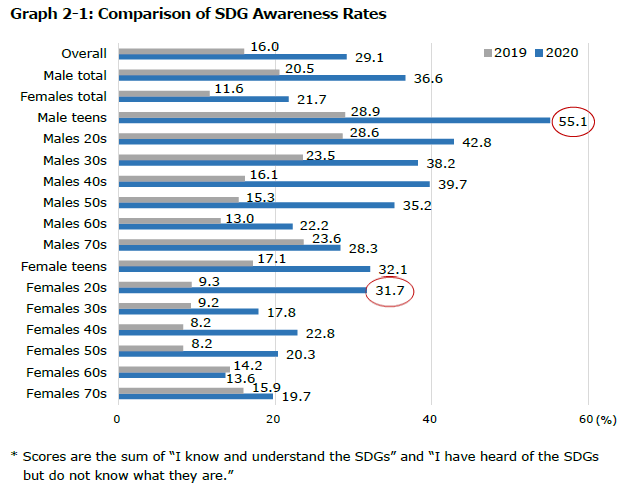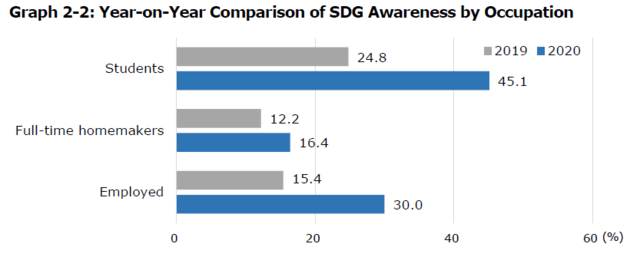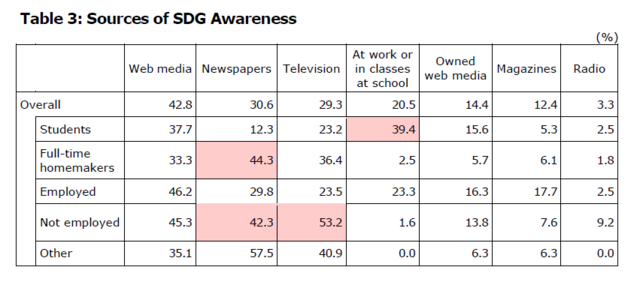Dentsu Inc. (Headquarters: Minato-ku, Tokyo; President & CEO: Hiroshi Igarashi; Capital: 10,000 million yen), today announced that it has conducted its third Consumer Survey on the Sustainable Development Goals (hereinafter, "the survey"), which was carried out by Dentsu Team SDGs, a companywide working group tasked with promoting projects related to the SDGs.1 The survey gathered data across Japan from 1,400 male and female respondents between the ages of 15 and 79.
This survey looks at changes in the rate of awareness, sympathy, and lifestyle intentions since the previous survey. In order to predict their future behavior, consumers were also polled regarding the trends they expect will increase.
The key findings of the survey may be summarized with the following three points.
1. Keen to avoid plastics; back minimalism, shared & circular economies
When asked about lifestyle behaviors related to realizing the SDGs, approximately 70% of consumers indicated moving away from plastic, which would limit the use of plastic materials (70.3%). Approximately 50% of consumers were aware of minimalism, a lifestyle focused on consuming as little as possible, without a fixation on purchases or ownership (54.0%). Approximately 40% were aware of the sharing economy, in which things, places, and skills are lent and borrowed (40.7%). Some 30% were aware of the circular economy, in which resources are reused and recycled, not thrown away (33.9%). Awareness of these trends was higher than awareness of the SDGs (29.1%).
2. More teleworking, autonomous driving expected
In terms of what consumers expect to see more, there is little social opposition to use of eco-bags. At the same time, consumers hope to see across the board increases in teleworking and autonomous driving. However, while teleworking ranks high among the trends consumers expect to see increasingly adopted--although they may not be able to put it into practice on a personal level2--many believe there will be social opposition to autonomous driving. Both trends are related to the three pillars of the SDGs Action Plan 20203 promoted by the Japanese government.
3. SDG awareness up at 29.1%; high among younger generations
Awareness of the term SDGs was 29.1%, an increase of 13.1 percentage points since the previous survey.4 The rate of increase was particularly high among males in their teens, females in their 20s, and other younger-generation segments. Awareness among students5 was approximately one person out of every two people (45.1%), an increase of 20.3 percentage points since the previous survey (24.8%).
Notes:
1. Sustainable Development Goals (SDGs): The goals were adopted by the United Nations Sustainable Development Summit in September 2015. The 193 countries of the UN General Assembly set the SDGs with the aim of achieving the goals during the 15-year period 2016-2030. The SDGs comprise 17 goals and 169 specific targets agreed by all UN member countries with the objective of solving major global issues and building sustainable societies.
2. With regard to teleworking and the sharing economy, due to the spread of COVID-19 after the conclusion of this survey, responses are, at present, expected to have changed substantially.
3. Source (Japanese only): https://www.kantei.go.jp/jp/singi/sdgs/dai8/actionplan2020.pdf.
4. The second survey, conducted in February 2019, and the third survey summarized in this press release differ in sample size, survey area, and other factors. Consequently, simple statistical comparisons cannot be made between the two surveys, and figures from the previous survey are provided for reference purposes only.
5. Students: This refers to the sum of elementary, junior high, senior high, college of technology, vocational, junior college, undergraduate university, postgraduate university, and other students.The teens surveyed were over 15 years old, but in the initial release, elementary and junior high school students were also listed in the category of Students. We apologize for this revision (corrected on February 17, 2021).
The 17 Sustainable Development Goals
1. No Poverty
2. Zero Hunger
3. Good Health and Well-being
4. Quality Education
5. Gender Equality
6. Clean Water and Sanitation
7. Affordable and Clean Energy
8. Decent Work and Economic Growth
9. Industry, Innovation, and Infrastructure
10. Reduced Inequality
11. Sustainable Cities and Communities
12. Responsible Consumption and Production
13. Climate Action
14. Life Below Water
15. Life on Land
16. Peace, Justice, and Strong Institutions
17. Partnerships for the Goals
Details of the Three Key Survey Findings
1. Moving away from plastic heads the list of lifestyle-related awareness, followed by minimalism and the shared and circular economies.
The following eight SDG-related lifestyle behaviors were presented, with questions asked regarding awareness, sympathy, and intention to follow. 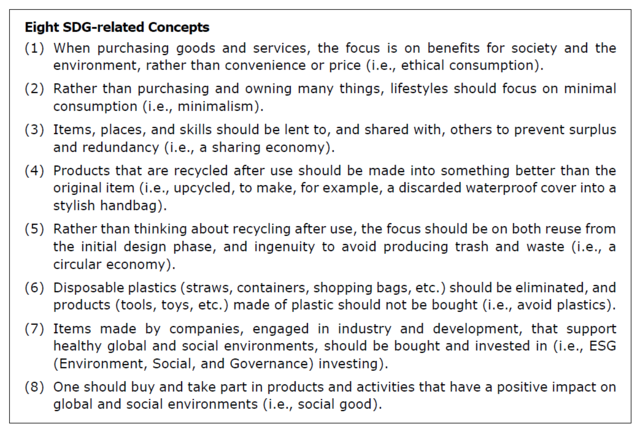
・Items that attracted a high degree of awareness were moving away from plastic (70.3%), toward minimalism (54.0%), and a sharing economy (40.7%). (Graph 1-1)
・Items attracting a high degree of sympathy were moving away from plastic (57.6%), toward minimalism (48.6%), and a circular economy (44.4%). (Graph 1-2)
・Items that users intended to incorporate into their lifestyles (intention to put into practice) were moving away from plastic (54.2%) and toward minimalism (49.7%). (Graph 1-3)
・When awareness, sympathy, and intention to put into practice are combined on a point basis, the highest score goes to the intention to move away from plastic (182.2 percentage points), followed by moving toward minimalism (152.3 percentage points) and a circular economy (107.2 percentage points). (Graph 1-4)
The intention to move away from the use of plastic ranks at the top in terms of awareness, sympathy, and intention to put into practice. It is possible that, when there is a difference in rates of awareness, sympathy, and intention to put into practice, there may be no products and services available for practical use. This could indicate an area in which future environmental development may be possible.
Graph 1: Addressing Eight Concepts Linked to the SDGs
2. Consumers expect to see more teleworking and autonomous driving, potentially changing lifestyles.
Forty-eight keywords related to various industries and based on industry categories in the Global Compact SDG Industry Matrix were presented to respondents, who were asked to choose which items they expect to see increase, from societal and personal perspectives.
・ The categories most expected to show the greatest increase throughout society were eco-bags (48.2%), autonomous driving (47.9%), teleworking (40.3%), electronic health records (39.1%), and side jobs (37.3%). (Table 1-1)
・ Among these, the categories expected to face fewer opposing opinions and least resistance were eco-bags (42.6%), electronic health records (31.6%), and teleworking (29.3%). (Table 1-2)
・ Conversely, as they expand, the categories expected to face the most opposing opinions and resistance were acceptance of immigrants (15.2%), surveillance cameras in public spaces (14.6%), and environmental taxes (12.3%) (Table 1-3)
Expectations are high that social mechanisms will change dramatically to improve individuals' quality of life.
・At the same time, categories ranked highest in terms of what respondents thought would increase were eco-bags (45.9%), stores that sell leftover and overstocked merchandise (34.6%), teleworking (33.1%), reuse of waste (32.9%), and preventive healthcare (30.6%). (Table 2-1)
・When asked what activities respondents could proactively increase or engage in, the top responses were use of eco-bags (43.9%), using stores selling overstocked items (30.7%), reuse of trash (27.5%), consumption of locally produced products (24.6%), and preventive healthcare (21.0%). (Table 2-2].
・Top categories that respondents cannot proactively increase or engage in were days off (5.9%), long-term childcare leave for men (5.2%), and teleworking (4.8%). (Table 2-3) If the actions and initiatives of individuals and corporations were to dovetail, it is possible that these efforts would spread rapidly.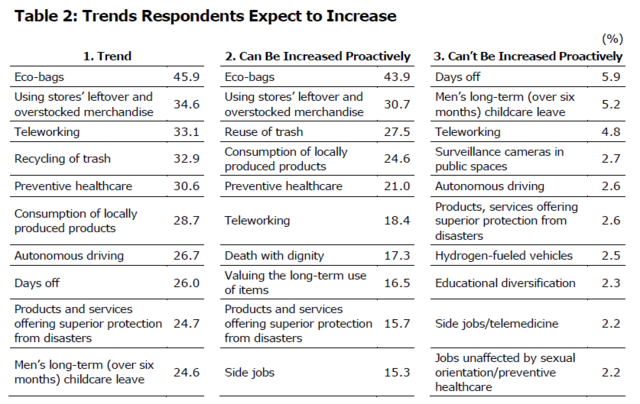
In addition, the survey reveals that categories respondents believe will increase (Table 1-1) and those they personally wish would increase (Table 2-1) align with the three central pillars of the Japanese government's SDGs Action Plan 2020.6 Teleworking ranked high in terms of trends expected to increase nationwide, and as an activity in which respondents want to engage, as did autonomous driving, which is expected to increase nationwide. The activities are related to three main pillars: business and innovation; regional revitalization and community development; and next-generation and female empowerment.
Notes:
6. The three main pillars of the SDGs Action Plan 2020 are, (1) Business and Innovation: Promotion of Society 5.0 that Corresponds to the SDGs; (2) Regional Revitalization Driven by the SDGs: Creating Attractive Cities That Are Resilient and Environmentally Friendly; and (3) Empowerment of the Next Generation and Women as Leaders of the SDGs.
3. SDG awareness up at 29.1%; high among younger generations
According to the survey, 29.1% of respondents had heard the term SDGs. (Graph 2-1) This is a 13.1 percentage point increase in the year since the previous survey, in which awareness was 16.0%. Compared with the results of the first survey conducted in 2018, in which the awareness rate was 14.8%, 2019 survey results show an increase of only 1.2 percentage points, indicating that over the past year, the SDGs have become more widely accepted as a matter of social interest and concern.
・Looking at survey responses by sex and generation, with the exception of females in their 60s, the rate of awareness is rising across all generations. Awareness appears to be rising rapidly among males in their teens (2019: 28.9% → 2020: 55.1%, +26.2 percentage points, females in their 20s (2019: 9.3% → 2020: 31.7%, +22.4 percentage points, and members of younger generations.
・Comparing awareness of the term SDGs by occupation, students ranked highest, with approximately half (45.1%) being aware. This is an increase of 20.3 percentage points since the previous survey. (Graph 2-2) In terms of both generation and occupation, the results indicate that the generations of future leaders have a great interest in the SDGs. Probably one reason for the high rate of recognition among students is that they are taught about the SDGs at school. (Table 3)
Comment by Ms. Martina Donlon
Acting Chief, Sustainable Development Section
Department of Global Communications
United Nations
These are very encouraging survey results. The fact that more than 40% of students are aware of the Sustainable Development Goals speaks to the excellent work done integrating the SDGs in the school curricula in Japan. Young people are a crucial target audience, and it would be great to see more schools around the world follow Japan's example and teach students about the SDGs.
It is also promising to see that a majority of respondents are ready to put the SDGs into practice, through changes in their daily habits - moving away from plastics, using reusable eco-bags and doing more teleworking - which all contribute to reducing the pressure on the environment. At the same time, the social components of the SDGs - like gender equality or supporting marginalized communities such as immigrants - deserve equal attention and urgency. We have ten years left to achieve the SDG by the 2030 target date. Everyone everywhere can do their part to help build a fairer, more sustainable world.
Outline of Third Consumer Survey on Sustainable Development Goals
Objective: Investigate the current status of awareness and understanding of the SDGs in Japan, as well as interest in the SDGs. Based on this, consider possible strategies for future promotion of awareness and action relating to the SDGs.
Survey area: Nationwide in Japan
Respondents: Males and females, aged between 15 and 79 years
Sample size: Groups of 100 males and 100 females in each of seven age categories, together comprising 1,400 persons
For analysis purposes, the sample was weighted in proportion to the distribution of population among Japan's 47 prefectures, and also in correspondence with the age group ratios for Japan's population.
Survey method: Internet-based survey
Survey period: January 18-19, 2020
Survey institution: DENTSU MACROMILL INSIGHT, INC.
* The figures presented in this press release's graphs have been rounded to the nearest unit. Consequently, some totals do not match the sum of the data components shown.
#####
Contact
Media-related enquiries: Corporate Communications Division
E-mail: global.communications@dentsu.co.jp
Report-related enquiries: Team SDGs, Dentsu
E-mail: team-sdgs@dentsu.co.jp

